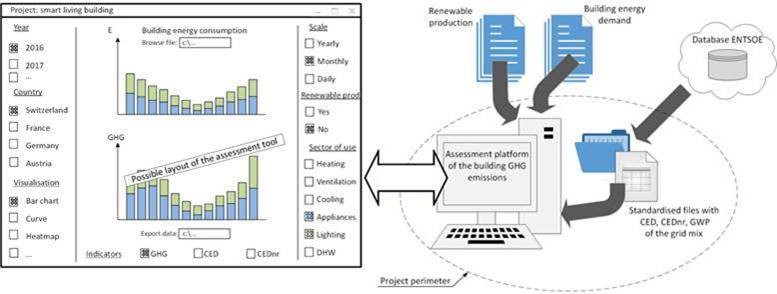ECABO tool

The goal of the proposed project consists of prototyping an interactive software targeted towards building designers and building managers, that would allow them to rapidly and dynamically assess and visualize the GHG emissions during the operation phase of a given building.
Fig. 1: Overview a possible layout of the prototyped tool (left), and of the necessary inputs and outcomes of the project (right)
This prototype will, in an analogous way to dealing with the GHGs, process the cumulative energy demand (CED) and its non-renewable part (CEDnr) that are often also subject to regulation and norms (e.g. SIA, ISO). The prototype will become de facto a demonstrator, raising the awareness not only of its primary users but also of the general public about GHG emission in buildings.
The prototype will become de facto a demonstrator, raising the awareness not only of its primary users but also of the general public about GHG emission in buildings. A synthetic scheme of the prototyped software and the different information fluxes is presented in Fig. 1. The input data necessary to run this software are:
-Yearly standardized files providing the hourly GWP, CED and CEDnr expressed for one kWh of electricity supplied by a given grid;
-the building energy demand and the possible on-site renewable energy production, input by the software user (obtained through dynamic energy simulations, e.g. using EnergyPlus, Lesosai, or measured in existing building).
This prototyped assessment software will include different data visualisation routines helping to understand when and for which use (e.g. heating, ventilation, appliances, lighting, cooling) GHG emissions are becoming critical. A module will enable to incorporate possible data of renewable energy production and the assessment of energy balances over different time scale. The results provided by the prototyped software will enable in particular:
– to perform robust and accurate GHG and energy impacts assessments based on hourly life cycle inventories;
– to identify possible timing optimization of electricity use for energy and GHG emissions mitigation;
– to establish the upper limits of energy and GHG emissions footprints that onsite renewable and energy storage systems should exhibit when designing energy system for low carbon buildings.
Partners
Project leadership: EPFL Building2050: Dr. Didier Vuarnoz
Academic partner: UNI-FR, Human-IST Institute: Prof. Denis Lalanne
Industrial partner: Energie concept SA: Thierry Dewarrat (CEO) ; ESU services Ltd: Dr. Niels Jungbluth (CEO)
Funding
State of Fribourg – Switzerland
Please note that the publication lists from Infoscience integrated into the EPFL website, lab or people pages are frozen following the launch of the new version of platform. The owners of these pages are invited to recreate their publication list from Infoscience. For any assistance, please consult the Infoscience help or contact support.